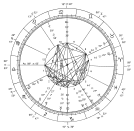Panch Mahapurusha yoga
| Astrology |
|---|
 New millennium astrological chart |
| Background |
| Traditions |
| Branches |
|
|
Panch Mahapurusha yoga is formed when any one of the five Tara-grahas or non-luminary planets are at the time of birth situated in their own sign or in their exaltation sign in a kendra (cardinal house) from the Lagna (Ascendant) . These yogas ensure a successful and prosperous life.
Constitution
Only the non-luminaries, that is, any one of the five planets other than the Sun and the Moon, can give rise to a Panch Mahapurusha yoga by occupying any one of the two signs they own or by occupying their exaltation sign, in a kendra from the Janma Lagna.[1] According to Saravali these planets situated likewise from the Chandra Lagna (Natal Moon) also give rise to the Panch Mahapurusha yogas.
These five planets i.e. Mercury, or Venus or Mars or Jupiter or Saturn give rise to the Bhadra yoga,[2] the Malavya yoga,[3] the Ruchaka yoga,[4] the Hamsa yoga[5] and the Sasa yoga[6] respectively; they then exert a powerful influence that uplifts the person above the level of the ordinary[7]
Yoga effects
These afore-named five yogas influence all individual actions, endeavours and efforts. Their effects are not dasha - dependent, but they do give exceptional success in their dasha and antra-dasha. According to Phaladeepika (Sloka VI.4) one such yoga makes a person fortunate; two, equal to a king; three, a king; four, an emperor and five, superior to an emperor. Other good yogas if also caused simultaneously by these planets enhance their good results., any aspect or conjunction modifies these yogas, if with the Sun or the Moon cancels these yogas. Sasa yoga is generally not a happy one it gives a pained personality, and for whom success results after severe hard work and perseverance compelled by fears.[8]
These are the five planetary combinations for greatness, prosperity and happiness depending upon the nature and mode of functioning of the planet on physical and psychological sheaths that function on the objective plane. Planets thus situated enable accomplishment of exceptional results. A right appraisal requires a very careful study of the forces involved in these combinations which do not require collective occupation.[9] because the Panch Mahapurusha yogas are frequently observed and rarely found to be fully expressing their ascribed results unless the relevant planet is also strong duly vested with Sthana bala,Diga bala, Kala bala or Cheshta bala.[10]
Ineffectiveness of yoga
An exalted planet which occupies a kendra or a kona gives yoga results only if its dispositor is strong i.e. well - placed, not combust and not afflicted by malefic or papa-grahas.[11] even though three or more planets in exaltation in the kendras or in the trines do give rise to Raja yoga.[12] Moreover, the auspicious results of these yogas are experienced when the planets giving rise to the Panch Mahapurusha yoga, are as functional benefics strong Shadavarga-wise, they own only auspicious and benefic bhavas (houses), they are neither in Rasi-sandhi or Bhava-sandhi, nor afflicted by inimical or malefic planets (papagrahas) or bhadakadhipatis, they do not occupy inimical, malefic or debilitation portion of the sign, they are very near the point of their highest exaltation and do not conjoin with either the Moon or the Sun. This is the main reason that the frequently occurring Panch Mahapurusha yogas do not produce their ascribed results. In the case of a nativity that had three Tara-grahas exalted in the kendras the person led a very ordinary struggling life all because the 11th house ruled by Venus was vacant and Venus was powerfully placed exalted in the 4th house.[13] In contrast is the case of T.N.Seshan who was destined to avail the full benefits of the flawless Sasa yoga and Malvaya yoga; in his case Saturn in Sasa yoga from Capricorn lagna and Uttarashada nakshatra aspects Venus in Malavya yoga and situated in the 10th house.[14]
The dashas of the yogakarakas and the Rajayogakarakasshould run their course during the period of one's life when their results will matter and can be best enjoyed, this depends upon the Moon occupying the appropriate nakshatra and the concerned dasha-lords also occupying auspicious nakshatras as the rulers of auspicious nakshatras counted from the Janamanakshatra without their own nakshatras becoming afflicted, such a pristine situation does not generally exist.[15]
References
- ↑ Janardan Harji. Mansagari. Varanasi: Savitri Thakur Prakashan. p. 214.
Chapter IV Verse 1
- ↑ Bangalore Venkata Raman. Three Hundred Important Combinations. New Delhi: Motilal Banarsidass Publishers. p. 53.
- ↑ Bangalore Venkata Raman. Three Hundred Important Combinations. New Delhi: Motilal Banarsidass Publishers. p. 48.
- ↑ Bangalore Venkata Raman. Three Hundred Important Combinations. New Delhi: Motilal Banarsidass Publishers. p. 51.
- ↑ Bangalore Venkata Raman. Three Hundred Important Combinations. New Delhi: Motilal Banarsidass Publishers. p. 43.
- ↑ Bangalore Venkata Raman. Three Hundred Important Combinations. New Delhi: Motilal Banarsidass Publishers. p. 49.
- ↑ "Know about panch maha purush yoga".
- ↑ Ernst Wilhelm. Core Yogas. Kala Occult Publishers. pp. 45–60.
- ↑ Bepin Behari. Esoteric Principles of Vedic Astrology. Sterling Publishers (P) Ltd. p. 194.
- ↑ Dr. K.S.Charak. Yogas in Astrology. Institute of Vedic Astrology. p. 77,87.
- ↑ Hart De Fouw. Light on Life. Lotus Press. p. 285.
- ↑ Bangalore Venkat Raman. Three Hundred Important Combinations. Motilal Banarsidass Publishers. p. 238.
- ↑ Dr. Bhojraj Dwivedi. Diamond Horoscope 2007 – Aries. Diamond pocket Books (P) Ltd. p. 87.
- ↑ Bepin Behari. Astrological Biographies:Seventeen examples of Predictive Insights. New Delhi: Motilal Banarsidass Publishers. p. 303.
- ↑ Ravinder Kumar Soni. Planets And Their Yoga Formations. New Delhi: Pigeon Books India. p. 102. Retrieved 07.12.2012. Check date values in:
|access-date=(help)